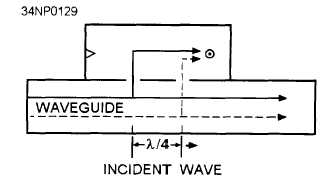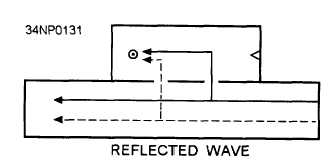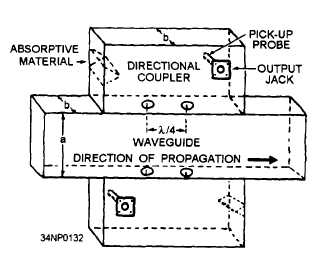between the sample energy and the energy in the
waveguide is constant. Otherwise, the sample would
contain no useful information. The ratio is usually
stamped on the coupler in the form of an attenuation
factor.
and the probe are in opposite positions from the
directional coupler designed to sample the incident
energy. This positioning causes the two portions of
the reflected energy to arrive at the probe in phase,
providing a sample of the reflected energy. The
transmitted energy is absorbed by the absorbent
material.
Figure 3-56.—Incident wave in a directional coupler
designed to sample incident waves.
The effect of a directional coupler on any reflected
energy is illustrated in figure 3-57. Note that these
two waves do not travel the same distance to the
pickup probe. The wave represented by the dotted
line travels
further and arrives at the probe 180
degrees out of phase with the wave, represented by
the solid line. Because the waves are 180 degrees
out of phase at the probe, they cancel each other and
no energy is induced into the pickup probe. When
the reflected energy arrives at the absorbent material,
it adds and is absorbed by the material.
Figure 3-57.—Reflected wave in a directional
coupler.
A directional coupler designed to sample reflected
energy is shown in figure 3-58. The absorbent material
Figure 3-58.—Directional coupler designed to sample
retlected energy.
A simple bidirectional coupler for sampling both
transmitted and reflected energy can be constructed
by mounting two directional couplers on opposite sides
of a waveguide, as shown in figure 3-59.
Figure 3-59.—Bidirectional coupler.
Resonators
definition, a resonant cavity is any space
Cavity
By
completely enclosed by conducting- walls that can
contain oscillating electromagnetic fields and possess
resonant properties. The cavity has many advantages
3-26








